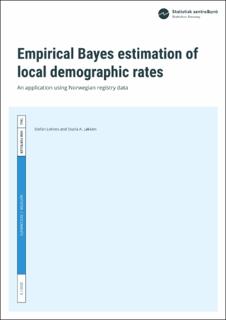| dc.description.abstract | Local governments and businesses rely on regional population projections to make informed planning and policy decisions.
A prerequisite for producing reliable regional projections is access to high quality demographic rates. However, it is difficult to produce local demographic rates in a setting where many populations are small.
To solve the small area problem, we propose the use of hierarchical empirical Bayes (EB) methods. It provides a unified framework for estimating local age-specific rates for fertility, mortality, internal migration and emigration. This method also produces rates that are stable and regular across all types of municipalities while still allowing substantial local heterogeneity.
In this document, we contribute by describing an efficient and low-cost method for implementing the technique, which can easily be used by other practitioners using off-the-shelf statistical software packages. We demonstrate how the EB-method outperforms naïve estimates of local demographic rates. Finally, we provide fact sheets with results for all municipalities, demonstrating the performance of the method. | en_US |
